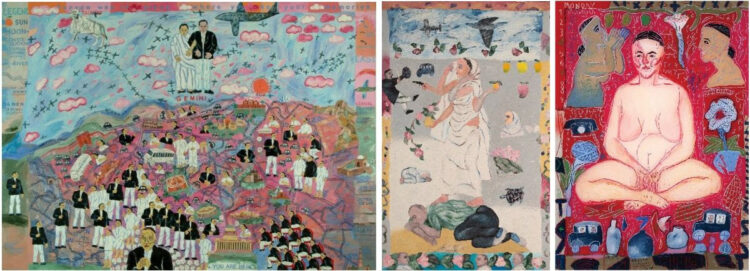The Serpentine Galleries presents a groundbreaking solo exhibition celebrating the extraordinary career of Arpita Singh, one of India’s most renowned contemporary artists. ‘Remembering’, on view at Serpentine North from March 20 to July 27, 2025, offers a rare opportunity for London audiences to immerse themselves in over six decades of Singh’s prolific practice. This is the first institutional solo exhibition of Singh’s work outside of India, making it a monumental moment in her career and a must-see event in London’s art scene.
Arpita Singh: A Pioneer in Contemporary Indian Art
Born in Baranagar in 1937, Arpita Singh has redefined modern Indian art with her unique style, blending Surrealism, Indian Court painting, and bold figuration. Her works delve into complex themes of gender, mythology, and social upheaval, often using vibrant colors and intricate compositions to create thought-provoking narratives.
Singh’s oeuvre spans diverse mediums, including oil paintings, watercolors, and ink drawings, showcasing her ability to experiment endlessly with color and texture. This exhibition brings together iconic works like “Devi Pistol Wali” (1990) and “A Feminine Tale” (1995), each demonstrating her mastery in exploring emotional and societal complexities.
Remembering: An Invitation to Interpret and Imagine
The title ‘Remembering’ encapsulates the essence of Singh’s work—a reflection of memories, experiences, and collective histories. Singh invites viewers to interpret her layered compositions, where contrasting symbols and words often create a dialogue between the personal and the universal.
As Singh explains:
“When the work grows, the starting point melts. I, the woman, stand there as anybody, as everybody.”
This idea resonates throughout the exhibition, as Singh resists singular interpretation, offering viewers the freedom to engage with multiple meanings. Her ability to juxtapose symbols—such as turtles, airplanes, and portrait busts—within a single composition creates a dynamic viewing experience.
Highlights from the Exhibition: Iconic Works and Techniques
Devi Pistol Wali (1990)
This early masterpiece reimagines the Hindu goddess Devi standing powerfully in an outdoor space, adorned with mythological and modern symbols. Singh’s use of floral borders and repeated motifs connects traditional Indian miniature painting to contemporary life, emphasizing the resilience and complexity of women in public spaces.
A Feminine Tale (1995)
One of Singh’s reverse paintings, this work explores themes of solitude, sensuality, and contemplation. Using the back of an acrylic sheet, Singh creates a striking contrast of gold, crosses, and abstract symbols, showcasing her experimental approach to form and technique.
My Lollipop City: Gemini Rising (2005)
This large-scale cityscape blends the bustling streets of New Delhi with celestial symbols like “GEMINI” and “SUN.” Singh’s intricate map, complete with monuments and horoscope references, invites viewers to navigate the dissonance between orientation and disorientation.
Exploring Themes of Gender and Resilience
From the 1990s onward, Singh’s work has increasingly focused on themes of gender, motherhood, and vulnerability, often portraying women navigating societal and political challenges. These themes resonate deeply, particularly as Singh draws attention to how historical and contemporary events uniquely impact women.
Her recurring use of symbols—mangoes, jars, and flowers—becomes a language of its own, weaving stories of identity, struggle, and empowerment. Singh’s ability to blend personal narratives with larger societal issues has made her a pioneering voice in contemporary art.
A Dialogue Between East and West
Singh’s works not only highlight her mastery of Indian artistic traditions but also engage with global concerns. Her paintings bridge Bengali folk art, modernist explorations of identity, and contemporary humanitarian crises. The exhibition builds on Serpentine’s legacy of spotlighting underrepresented artists, following past shows featuring trailblazers like Faith Ringgold and James Barnor.
Curators Bettina Korek and Hans Ulrich Obrist emphasize Singh’s influence, saying:
“For more than half a century, Arpita Singh has vividly portrayed life and imagination, uniting the personal and the universal.”
Beyond the Exhibition: A Comprehensive Catalogue
To accompany the exhibition, Serpentine will release the most comprehensive publication on Singh to date. Featuring contributions from renowned voices like Geetanjali Shree, Geeta Kapur, and Nikita Gill, the catalogue will provide deep insights into Singh’s artistic journey and influence. Designed by Mark El-Khatib Studio, this publication is a testament to Singh’s significant role in shaping contemporary art across generations.
Why ‘Remembering’ is a Must-See
For lovers of art and innovation, ‘Remembering’ offers a rare chance to explore the intersection of tradition and modernity. Singh’s ability to tackle universal themes through vibrant imagery and layered narratives creates a deeply engaging experience. Her work not only reflects Indian history but also prompts audiences to consider their own perspectives on identity, resilience, and humanity.
Located in the heart of London, Serpentine North provides the perfect setting for this monumental exhibition. Whether you’re an art aficionado or a curious newcomer, Singh’s work will leave a lasting impression.
Plan Your Visit
Don’t miss this historic exhibition. Visit Serpentine North from March 20 to July 27, 2025, to experience the world of Arpita Singh. Admission is free, ensuring everyone can explore this extraordinary showcase of creativity and meaning.
